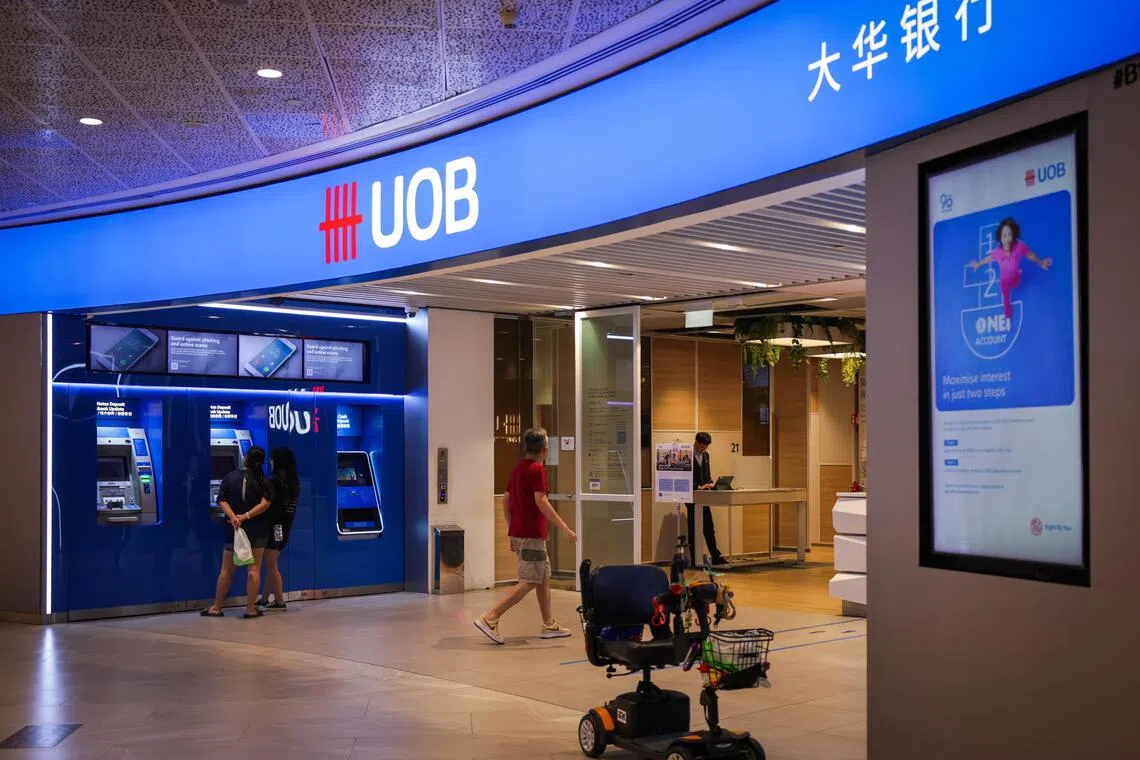UOB third-quarter profit tumbles 72% as bank hikes allowances by $1 billion
Sign up now: Get ST's newsletters delivered to your inbox

UOB noted that its dividend payment would not be affected by the pre-emptive general allowance.
ST PHOTO: GIN TAY
Follow topic:
SINGAPORE - UOB on Nov 6 posted a sharp 72 per cent drop in third-quarter net profit to $443 million from $1.61 billion in the year-ago period on a surge in credit provisions.
Allowances for credit and other losses more than quadrupled to $1.36 billion, from $304 million a year earlier, as the bank said it “took proactive steps to strengthen its provision coverage amid ongoing macroeconomic uncertainties and sector-specific headwinds”.
This lifted general allowance coverage to 1 per cent of performing loans. The general provisions cover all sectors, including small- and medium-sized enterprises as well as multinational corporations.
UOB’s shares took a hit on the news, falling as much as 4.6 per cent to $33.25 in early trading on Nov 6 before paring losses to close 2.78 per cent down at $33.90.
“We proactively set aside general allowances to significantly enhance provision coverage, backed by our strong capital base,” said deputy chairman and chief executive Wee Ee Cheong. UOB noted that its dividend payment would not be affected by the pre-emptive general allowance. It also remains committed to its $2 billion share buyback programme, with nearly a quarter of it completed as at September. It also remains committed to its $2 billion share buyback programme, with nearly a quarter of it completed as at September.
As a result of the provisions hike, UOB’s earnings for the July to September quarter fell well short of the $1.34 billion forecast in a Bloomberg poll of analysts. Before the allowances and at the operating level, profit fell 16 per cent year on year to $1.86 billion from $2.21 billion.
Speaking at the bank’s results briefing on Nov 6, Mr Wee said UOB’s decision to increase allowances is akin to “buying insurance”.
It allows the bank to be in a “position of strength” and avoid forcing property sales of potentially distressed borrowers, he added.
“Otherwise, when you have a crisis situation, the tendency is that everyone will overreact… Do you want to do that?” said Mr Wee. “No, we want to set aside (allowances), we want to be calm and we want to be measured.”
Mr Wee declined to identify the borrowers linked to the higher allowances, which include $615 million in additional general allowances and higher specific allowances on loans, mainly to the commercial real estate sector in the United States and Greater China.
The non-performing loan (NPL) ratio for loans in the US increased to 4 per cent in the third quarter from 2.4 per cent a year earlier, while that for Greater China rose to 3.1 per cent from 2 per cent.
Overall NPL edged up to 1.6 per cent from 1.5 per cent a year earlier.
Net interest income fell 8 per cent to $2.3 billion, as net interest margin – the key difference between what banks earn on loans and what they pay on deposits – narrowed by 23 basis points to 1.82 per cent, from 2.05 per cent a year ago. Non-interest income came in at $1.1 billion, down from $1.4 billion previously, due to higher card rewards expenses and lower trading and investment income.
UOB expects its full-year net interest margin in 2026 to come in between 1.75 per cent and 1.8 per cent, below the projected 1.85 per cent to 1.9 per cent for 2025.
The bank also forecasts low single-digit loan growth and high single- to double-digit fee income growth for 2026. Credit costs, which surged to 134 basis points in the third quarter from 36 basis points a year earlier, are expected to fall back to 25 to 30 basis points.
Mr Glenn Thum, research manager at Phillip Securities Research, said that UOB is likely to continue lowering its cost of funds to cushion its net interest margin as global interest rates decline.
He said: “The bank is expected to maintain its dividend payout ratio at 50 per cent, with the $615 million in pre-emptive general provisions added back for the financial year 2025 dividend calculation.
“Including a special dividend of 50 cents, the total payout ratio for financial year 2025 is estimated at about 70 per cent.”
Mr Tay Wee Kuang, research analyst at CGS International Securities Singapore, said the investment house is maintaining its “hold” call on UOB’s shares with an unchanged target price of $38.30.
“Potential upside risks include more resilient net interest margins, which could support growth in net interest income if US rate cuts are less steep than expected, as well as sustained double-digit growth in non-interest income and possible write-backs of credit costs,” he said. “Downside risks include weaker macroeconomic conditions that may prompt higher general provisions, weighing on earnings and a slowdown in non-interest income growth.”


